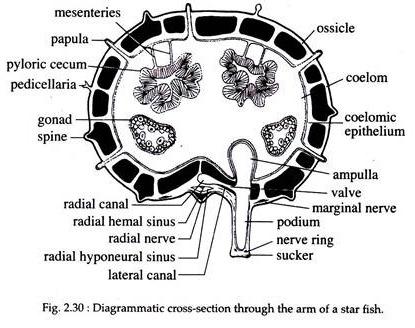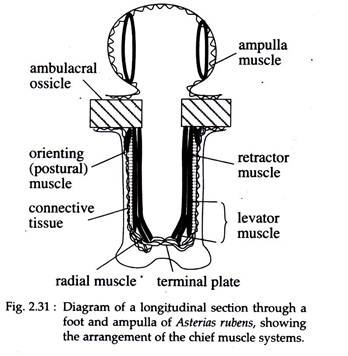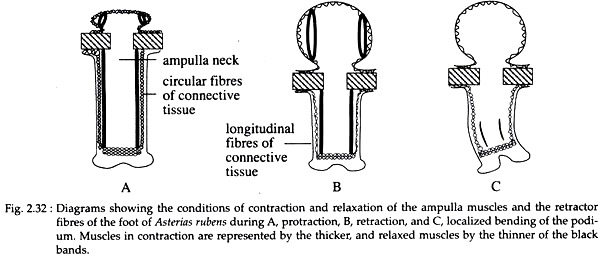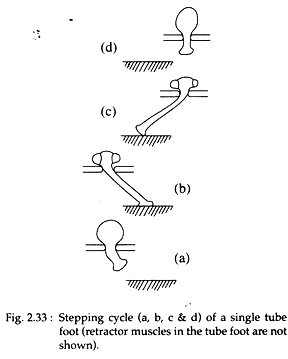In this article we will discuss about Locomotion in Star Fish in Relation to Tube Feet:- 1. Introduction to Star Fish 2. Structure of Tube Feet in Star Fish (Asterias) 3. Role of Tube Feet in Locomotion 4. Control.
Introduction to Star Fish:
Star fishes (Asterias) are the members of phylum Echinodermata which possess a characteristic hydrostatic skeleton. The operation of a coelomic hydrostatic skeleton has most extensively been studied in echinoderms.
In asteroids (star fishes), the coelomic body cavity is well developed, but the body wall being rigid, peristaltic movement is not possible. So, their locomotion depends upon the coelomic spaces extended into the tentacles and water vascular system.
In Asterias, the water vascular system bears tube feet and has a central coelomic cavity that transports sea water within the animal. Tube feet are short tubular external projections of the body wall located in the ambulacral groove. Sharpey in 1836 first referred the organ as “…….. membranous tubes, named the feet”.
ADVERTISEMENTS:
By the turn of nineteenth century, the term “podia” was being used increasingly, along with “tube feet”. In general, tube feet may be divided into two groups—the special feeding and /or sensory tube feet around the mouth and the tube feet of ambulacra of water vascular system.
Structure of Tube Feet in Star Fish (Asterias):
Along each arm of the starfish extends an open ambulacral groove, from which arises a series of tube feet or podia. These are arranged in two rows and usually have suckers at their tip. Each tube foot has a coelomic cavity that communicates by a narrow neck with an ampulla lying in the main perivisceral coelom.
Actually the ampulla is a small muscular sac that bulges into the aboral side and opens directly in a canal that passes downward between the ambulacral ossicles and leads into the tube foot or podium. Each ampulla is associated with a tube foot and forms with it a functional unit.
Like the body wall, the podium is covered on the outside with a ciliated epithelium and internally with peritoneum. Between these two layers, lie connective tissues and longitudinal muscle fibres (Figs. 2.30 and 2.31).
Role of Tube Feet in Locomotion:
In general, sea stars or star fishes move rather slowly and tend to remain within a restricted area. In Asterias, the entire water vascular system operates as a hydraulic system during locomotion. In Asterias forbesi, the circulating fluid enters each tube foot on the side of the ambulacral margin, and leaves it on the side of ambulacral axis, while the current enters the ampulla on its aboral side and leaves it orally.
Each tube foot-ampulla unit may be cut off from the rest of the water vascular system by a valve, so arranged as to maintain the pressure developed within the unit. The functioning of the unit depends upon differences between the musculature of the ampulla and the tube foot (Fig. 2.31).
In the ampulla the muscles consist mainly of rings of smooth muscles which are set vertically and lie parallel to the long axis of the arm. Contraction of these muscles brings about protraction of the tube foot and drives the fluid out of the ampulla into the foot.
ADVERTISEMENTS:
The increase in pressure is wholly translated into elongation of the foot that subsequently comes in contact with the substratum. The musculature of the tube foot, in contrast to that of the ampulla, consists of longitudinal muscles, which are bounded on the inner side of the coelom (Fig. 2.32).
Contraction of these muscles is followed by withdrawal of foot from the substratum, bending and shortening of the tube foot, and forceful return of the fluid back into the ampulla. All these make possible the highly organised stepping movement by which the star fishes pull themselves along (Fig. 2.33).
During the later half of nineteenth century, the locomotion of sea star was presumed to be by traction, that is, each podium performs a sort of stepping motion—the podium swings forward (Fig. 2.33a), grips the sub-stratum (Fig. 2.33b) and then moves backward (Fig. 2.33c).
In a particular section of an arm, most of the tube feet perform these steps in a highly co-ordinated manner and the animal moves forward. The tube foot also acts as lever, since a sea star can progress as well over sandy or greasy surfaces as over rock.
The forces exerted by the tube feet during horizontal and vertical locomotion were recorded and it was shown that either method may be used, according to the circumstances. In normal horizontal movement, the tube feet appear to act mainly as levers, since they can be seen to bend throughout their length, while in vertical movement the traction method appears to be used.
When a sea star is turned over, it can right itself by folding. The distal end of one or two arms twists, bringing the tube feet in contact with the substratum. Once the substratum has been gripped, the arms then move back beneath the animal so that the rest of the body is folded over. The animal may also right itself by arching its body and rising on the tip of its arms. It then rolls over onto its oral surface.
Control of Locomotion:
The control and co-ordination of sea star tube feet is a subject that has been studied quite extensively. Jennings (1907) showed the importance of the radial nerve and circumoral nerve ring in the pattern of co-ordination. Mangold (1921) evaluated the influence of the peripheral nervous system.
ADVERTISEMENTS:
The fine structure of the sucker disc of sea star tube feet has been studied by Chaet and Philpott (1960), who have shown that mucus glands within the suckers contain secretory packets, each of which has about 50 fibres, 20 µm in diameter arranged rather like the fibres of a mitotic spindle.
About 56 per cent of the total adhesive force exerted by each tube foot is created by the action of the sucker, while the remaining 44 per cent is due to the stickiness of the mucus. The adhesion of tube feet tip to the substratum is largely chemical.
When the star fish walks, adhesive carbohydrates and acidic proteins alternate with substances of different ionic contents, as a result the adhesion is broken and the tube feet get released.
In addition to locomotory function, tube feet of sea stars provide the principal gas exchange surface. It seems probable that the original function of the tube feet was respiration as the tube feet lay on either side of the food groove to derive advantages from the current down it.
Tube feet are the only appendages, possessed by all extant classes of Echinodermata that take pride of place as hydraulic organ in the animal kingdom.



